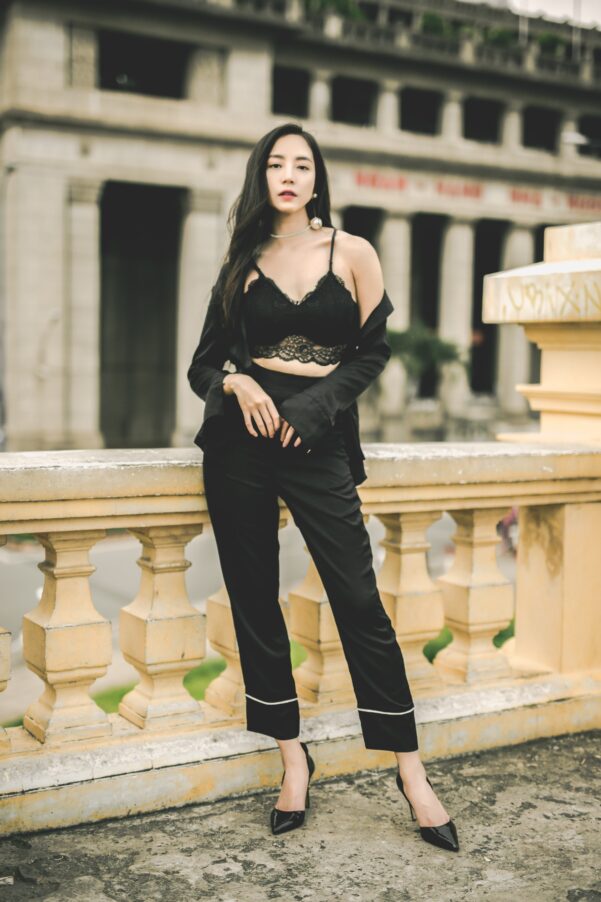We all remember the famous study on how wearing a white coat impacts our perception of our identity as well as the profound influence on our performance of a particular task – hence proving the notion of “enclothed cognition”. The sum of the experiment states that when the subjects were told that the coat was a lab coat, they were able to perform their tasks better, with greater focus and clarity, while those who were told it was a simple painter’s coat had no positive improvement in their performance.
So, if such an isolated example of a single piece of wardrobe has a monumental effect on our behavior, self-perception and performance, to what extent does our choice of wardrobe affect our self-image on a more permanent level? It’s yet another chicken-and-egg conundrum that makes us wonder how much we choose to ascribe value to a garment, and how much that particular item symbolizes our own value.
The Power Pose Effect
When you are anxious before a presentation, try doing a power pose. According to Amy Cuddy, a social psychologist studying the power of body language, a simple change in posture can completely alter your self-perception, increase your confidence and turn around a situation to your advantage. In short, our nonverbal cues are a significant part of our self-creation.
The same could be said for our clothing, especially since it makes for a large part of our visual presentation to the world. We have a long-standing culture of what counts as a business-worthy outfit, what it means to wear fitted clothes and what is considered “unconventional” or “rebellious”. The moment we put on a pantsuit or a pair of red Converse shoes, we’re not just making a statement, but we are literally putting ourselves into a predefined role that comes with a predetermined set of behaviors. It’s only natural, then, that those five-inch heels literally elevate your look, and a pair of fitness leggings puts us in the workout mindset.

The Qualities we Ascribe to Clothes
To elaborate a bit on the fact that our clothes already have personalities, let’s delve deeper into the matter of our everyday wears. Every color, fabric and shape have meaning, and when combined, they fit into a certain standard. Take, for instance, the little black dress. The color is associated with elegance, sophistication and power, the fabric of your choice will also invoke certain qualities, such as satin or silk that represent luxury and opulence.
Depending on the current fashion trends, we also give importance to the form of clothes, and so the oversized knitted pullover has become the go-to comfort piece, while maxi skirts with floral patterns epitomize the free-spirited boho movement. Naturally, when you put on a long, backless satin dress, you will feel like royalty, while based on professor Karen Pine’s research, a Superman T-shirt will instantly give you more confidence, and wearing a sweater during a maths test will help you get a higher score.
The Suitability Factor
And once again, society has developed a whole set of factors that play into the choice of your wardrobe and add to the intricate cycle of influence between our self and our style. Every culture, religion and the mindset of each society label a piece of clothing as appropriate or not for any given situation and environment. So, with the flow of evolution, our perception of clothes changes and what was once considered as upscale fashion is now outdated and ridiculous, while new styles emerge as the most desirable ones with which we wish to emulate beauty, success and savvy.
That is why brands adapt their creativity to respond to the needs and fluctuations of time and trends. So, one summer, it’s all about one-piece swimsuits, while by the time your next vacation comes, you’ll be wearing a bikini with vibrant colors that is designed to accentuate your curves. Of course, you won’t be wearing the satin dress to the beach, just like you won’t be wearing flipflops to the office, so when you hit a fashion jackpot with your style choices, your confidence and your self-esteem will flourish.

The Perpetual Creation of Self
The cultural and society-approved quality of our clothes is one, while our own personality is another part of this ever-changing equation. But there’s another curious element that will always give fluidity to the idea of using clothes as a means of self-expression, and that is, as the sociologist Georg Simmel would put it, the paradox of wanting to fit in and stand out at the same time.
This inner conflict is something we perpetually face when we open our wardrobes. We have the opportunity to wear a combination that screams uniqueness, but do we risk being judged and ostracized for our creativity, or do we put on the appropriate apparel for the occasion, thus blending in? In making a choice, we create ourselves every day, we conform, confront, and suppress our identity, either to be recognized as an integral part of our culture, or to be the labeled as the quirky lady who wears pajamas and Jimmy Choo boots to the office.




Join the discussion 2 Comments